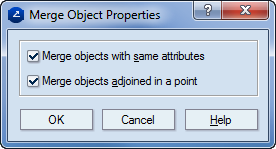Merging duplicated or adjoined objects
Duplicated objects can be:
- Two collinear lines (never axis lines).
- Two arcs with the same radii and orientation which have a common,
fully overlapping section, that is, two or more common points.
Adjoined objects can be:
- Two collinear lines (never axis lines).
- Two arcs with the same radii and orientation which have at least
one common point adjoining them.
To
merge duplicated or adjoined objects
- Select the objects you want to merge.
- Do one of the following:
- On the ,
click Delete Duplicated
 .
.
- On the Transformations menu, click Delete Duplicated.
The Merge Object Properties dialog box
appears.

- Consider the following cases, and then select the appropriate check
boxes:
CASE 1: To merge duplicated objects with the same styles and object
properties, select the Merge objects with same attributes check box. The
objects that will remain unmerged are:
- Duplicated objects in different styles.
- Duplicated objects in the same style but in different color or
line width.
- Objects which have only one common point, regardless of their style
and properties.
CASE 2: To make the style of the most recently drawn or modified object
among the original objects the style of the resulting merged line or arc,
select the Merge objects adjoined in a point check box.
CASE 3: To merge both duplicated and adjoined objects with the same
styles and object properties, select both check boxes. The objects that
will remain unmerged are:
- Duplicated objects in different styles.
- Duplicated objects in the same style but in different color or
line width.
- Objects in different styles which have only one common point.
- Click OK.
- A message appears with statistics about the segments and arcs that
have been merged.


